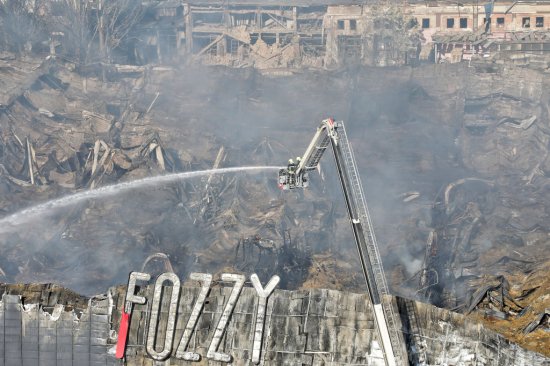
$300 billion of Russian assets have been seized since the Ukraine invasion. That money should be put towards rebuilding Ukraine
With each passing day, Ukraine continues to struggle under Russia’s illegal war of aggression and attrition. As the death toll rises and destruction mounts, a gridlocked U.S. Congress and passive parliaments among our allies make excuses for inaction. The United States and its G7 allies have already frozen over $300 billion in Central Russian Bank assets pursuant to lawful sanctions regimes. But those frozen funds have not yet been seized and transferred to Ukraine. Instead, they sit idle, generating profit and interest that Russia may eventually reclaim to perpetrate further war crimes, kidnap more Ukrainian children, and rape and murder even more innocent Ukrainian civilians.
[time-brightcove not-tgx=”true”]In the face of these atrocities, a long-overdue consensus is now forming among U.S. and European policymakers that the profit and interest generated on Russian assets (an estimated $3 billion per year) should be transferred to Ukraine for its defense and reconstruction. That proposed transfer—which targets the profit but not the underlying principal of Russian sovereign funds—is an important first step. But it should not be the last: the United States and its allies should go further and transfer the entire $300 plus billion of frozen Russian assets to Ukraine. Regrettably, however, the growing consensus to adopt a half-hearted compromise comes with an inaccurate concession that there are legal, financial, or geopolitical reasons not to fully cross the Rubicon rather than merely wading into it.
Rather than accept these “reasons” at face value, the Renew Democracy Initiative, a pro-democracy organization founded by former World Chess Champion Garry Kasparov, commissioned a comprehensive report to investigate the legal, practical, and moral dimensions of transferring Russia’s assets to Ukraine. As the report’s principal authors, we conducted this study with the help of a battery of brilliant associates at the leading law firm of Kaplan Hecker & Fink LLP and with invaluable input from experts around the world, including the International Working Group on Russian Sanctions, the New Lines Institute, and RAZOM.
After roughly half a year of careful analysis, we submitted our final report this September 17. Our report, which spans nearly 200 pages with some 740 carefully sourced footnotes, explains exactly why there is no basis for the ostensible legal doubts about whether the U.S. President has all the authority he needs under both domestic and international law to transfer to Ukraine the sovereign Russian assets frozen here.
Under legislation enacted by Congress 46 years ago, President Biden possesses the power to “compel” the “transfer” of Russia’s “property” to Ukraine in times of international emergency. In fact, President Biden has already made the necessary emergency declarations about the national security implications of Russia’s aggression against Ukraine, so he need only take the logical next step and transfer Russia’s frozen funds to the country Putin victimized. Such a step would be far from unprecedented: invoking the same legal authority, President George H.W. Bush transferred Iraq’s frozen assets in the U.S. to the U.N. Compensation Commission for victims of Iraqi aggression. There is no reason why President Biden should not do the same here.
Some critics of our proposal have warned that transferring Russia’s assets would infringe on Russia’s sovereignty and create a serious risk of so-called “de-dollarization.” But our report methodically dismantles those and many other supposed objections. At bottom, transferring Russia’s assets is fully consistent with international law and principles of sovereign immunity. As one of us has recently explained to the New York Times, “there is simply no basis for saying Russia can violate Ukraine’s sovereignty while invoking its own sovereignty as an inviolable shield” under international law. As for the potential harm to U.S. economic interests based on de-dollarization, that risk is overblown given the dollar’s structural advantages and the absence of viable alternatives. Former Treasury Secretary Larry Summers put it best: if the U.S. takes action along with its G7 allies (as we propose), “where are people going to move their money?”
That leaves the increasingly popular proposal of transferring the profits or interest generated by Russia’s frozen assets to Ukraine, while leaving the principal untouched—a compromise that has recently garnered support from Treasury Secretary Janet Yellen and some of her European counterparts. Accepting this proposal in lieu of the full transfer proposed by our report would be sorely mistaken. For one thing, the estimated $3 billion a year generated by Russian assets comes nowhere close to the hundreds of billions of dollars that Ukraine needs immediately for its defense and eventual reconstruction. For another, it’s hard to see why transferring the interest and profits earned on Russia’s frozen assets to Ukraine would avoid the purported legal pitfalls of an outright and complete seizure. After all, Russia has just as much an ownership claim to its interest/profits on its frozen assets as it does to the underlying principal. In our view, this false compromise amounts to little more than leaping partway across a gaping chasm simply because one has qualms about making the trip all the way across.
There can now be no justification for halfway measures, let alone for doing nothing while Ukraine is destroyed. Inaction is an illusion: it would represent a cowardly decision to appease and to encourage further aggression around the world.
TIME Ideas hosts the world's leading voices, providing commentary on events in news, society, and culture. We welcome outside contributions. Opinions expressed do not necessarily reflect the views of TIME editors.